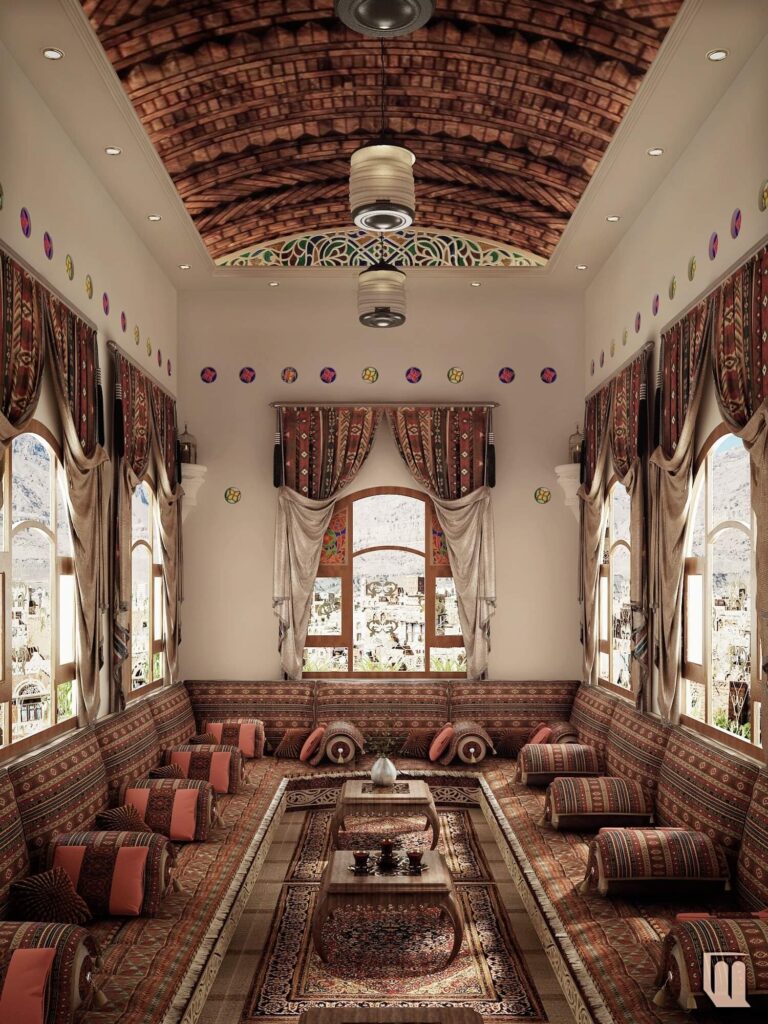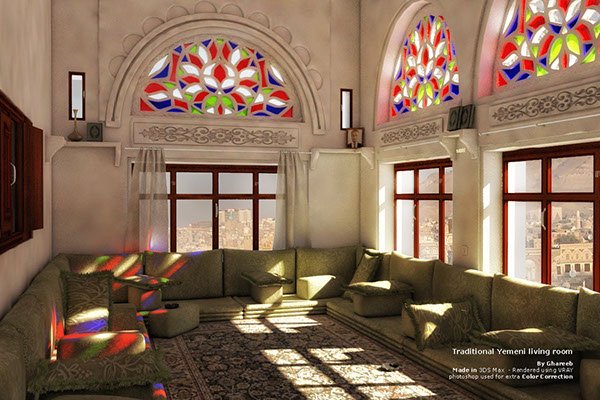The Architecture of the Diwan, A Traditional Yemeni Living Room
By: Menal Elmaliki / Arab America Contributing Writer
Sana’a must be seen, however long the journey,
though the hardy camel droop, leg-worn on the way-Traditional Yemeni Poem

Sanaa, the capital city of Yemen is a balance between old and new. The attempts of preserving old Sanaa’s architecture while also making it livable was successful, the streets are now busy, bustling with economic and social activity. Old Sanaa is considered, “the jewels of Muslim architectural and urban heritage,” and an archaeological wonder.
Walking along the alleyways of old Sanaa, admiring centuries old architecture one cannot help but wonder what lies behind these walls. As famous as the architecture of centuries old houses and buildings may be what is equally famous is what lies inside, past the brown mud bricks and intricate white detailing is the diwan translated as sitting quarters.
The Diwan is known as a collection of long and short romantic and narrative poetry but this diwan refers to a type of furniture and living room and similar to poetry, it has its own distinct style.
Common features of diwans are high ceilings, intricate detailing, curtains, and big windows. In more traditional diwans typically located in old Sanaa, the diwan will have cement walls with intricate details and mosaic windows. The mosaic and stain-glass windows are a work of an architectural genius, old Yemeni Architecture and design utilized the sun, its intention was to illuminate the living quarters. The sun will shine through the windows and its colors will light up the room thus creating a more intimate space in tune with nature.

The resilience of this centuries old architecture is partially due to its brick exterior and cement interior. These materials were best for maintaining temperature, blocking out noise- one can only imagine how loud the markets are, and it was fire resistant. These homes have cleaner indoor air since its duality presents it from deteriorating and concrete prevents the harbor insects and pesky rodents.
A regular living room is called a majilas but what makes it a diwan is it’s traditional furniture and unique features. A diwan, a living room, contains a divan, a type of furniture that resembles a bed, it has no back and arms instead there are cushions for the person to lean on. The diwan is popular in parts of the Arab world, not only Yemen, and it goes back to the Ottoman Empire. The word divans was coined because the furniture was commonly found in the council chambers of the Ottoman and Persian bureaucracy, the walls would be lined up with divans for government officials to mingle and rest. The usage of divan dates back to more than 2,000 years and it was used in liwans, narrow rooms with divan furniture, cushions, and carpets that were open and connected the outside courtyard to the private corridors. The liwan eventually became what is now known as the diwan, a modern lounge area or living room with traditional divan furniture.



The values and conservatism are deeply reflected in everyday life, the design or architecture of the house is influenced by Yemeni norms and culture. Privacy and the protection of women in the household are the main concern for many Yemenis and for this reason a house in Yemen contains separate quarters and a separate diwan for women. A house having more than one diwan will also reflect the economic status of the family, wealthier families will have more diwans than those of a lower economic status because of the high cost that comes with maintaining, furnishing and building one.
A majilas, the Arabic word for living room, but a diwan is a posh majilis with divan furniture. A house may contain a small majilas meant for families and big, lavish diwan is used to host large gatherings for weddings, religious holidays, celebrations and socializing. These living rooms are normally located on the 1st, 2nd or 3rdfloor and are decorated with niches, ornamented with elegant and posh divans, rugs or carpets, and chandeliers, Eid and other celebrations. More traditional houses will have mosaic or stain-glass windows while more modern houses will have grander windows with drapery panels or curtains. Diwans in older buildings will have traditional designs and newly built homes will have a more modern design.


Traditional, older diwan.
A house in Yemen will also contain a room called a muqaddimah, which is a simple room that is located in the entrance of the house and is usually for family or travelers. The diwan furniture in this room will be more simple and the room will be smaller. The point of the diwan is to give a space for the household and the guests to conjugate, socialize, smoke argila, and chew Qat.

Check out Arab America’s Blog!









